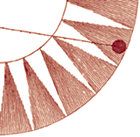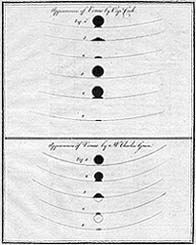During a transit, Venus appears as a small dark circle on the face of the Sun. Although it can be seen with the (suitably protected) naked eye, a telescope is essential to make useful observations of its motion and position.
.The favoured instruments of the major British expeditions of the 18th century were reflecting telescopes, which use a mirror rather than a lens as the primary optical component. The preferred supplier was James Short, who specialised exclusively in the manufacture of reflectors.
.The telescopes were used together with an expeditions clocks to see and time the key moments of a transit. By adding a micrometer, a telescope could also be converted into a measuring instrument, so that small angles such as the diameter of Venus could be accurately determined.






 The Transit Method
The Transit Method Transits in Print
Transits in Print Staging the Transit
Staging the Transit A Commercial and
A Commercial and  Transit Geography
Transit Geography Timing the Transits
Timing the Transits Viewing the Transits
Viewing the Transits Transit Places
Transit Places Oxford Observations
Oxford Observations Results
Results